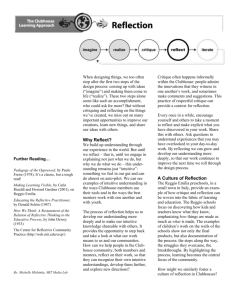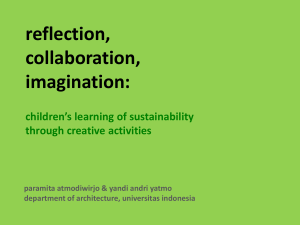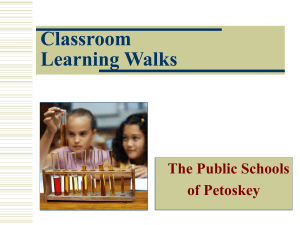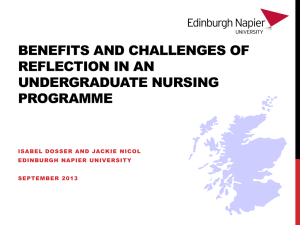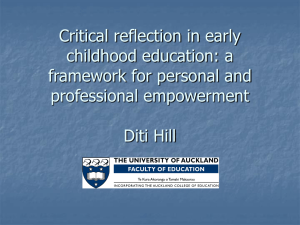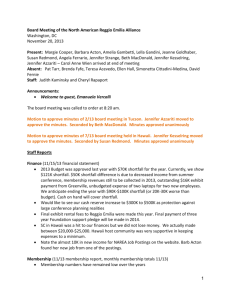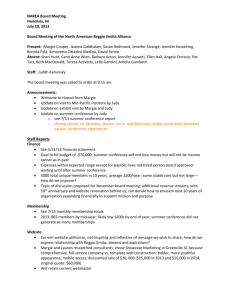`Assessing children`s learning`
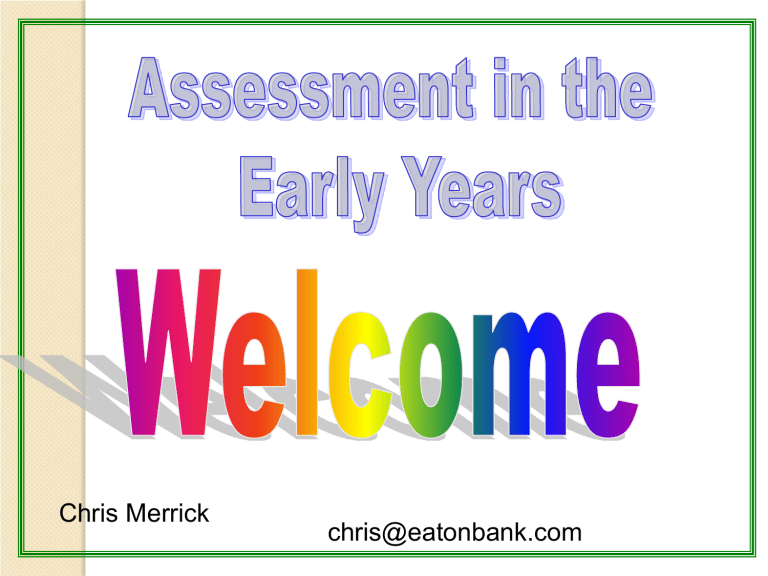
Chris Merrick chris@eatonbank.com
Why is how we think about assessment important?
We are living in a world demanding higher standards and increasing accountability.
Indications are that what we assess and the way we assess it has a huge impact on:
◦ what we teach,
◦ how we teach it,
◦ what children learn
◦ how they learn it
◦ most importantly, their attitudes to learning
Consider the impact of standardized testing in both the UK and America
Assessment needs to be consistent with your values and be grounded in your educational philosophy!
From 1993:
Assessment is “the ways in which, in our everyday practice, we observe children’s learning, strive to understand it, and then put our understanding to good use.”
Mary Jane Drummond
‘Assessing children’s learning’
To 2012
:
‘We have to see assessment as moving from judgment to description, a lot of our assessment procedures are reductive in the extreme,
Everything we know about teaching and learning tells us we achieve best when our expectations are raised and we are encouraged and supported. If we’re branded, if we’re stereotyped people tend to play unwittingly to the stereo type. So we need forms of assessment that are descriptive not judgmental and we need forms of assessment that are empowering rather than disenfranchising. What that really means are forms of assessment which focus on the complexities of learning rather than trying to reduce them to a single number or grade.’
Sir Ken Robinson
Learning without Frontiers Conference, 2012
In EC to what extent are we defined by ‘developmental norms’?
Who are Norm and
Norma and should everyone be just like them?
Some considerations for practice
Purpose – who and what is it for?
Authentic contexts
Includes multiple perspectives, neutrality and objectivity are often impossible
Checklists, tick lists and one off tests are of limited value.
Takes into account developmental aspects and their limitations
What is manageable, meaningful and worthwhile are value ridden
What do we want to create?
•
A positive medium which celebrates successes and values what we do and what the children do.
•A tool for children’s self assessment and a focus for conversations about learning;
•A means of communicating to parents about the life their child lives in the setting and a focus for their discussions;
•A way of explaining our work to the outside world.
•Information and evidence for practitioner’s professional reflection
• on children’s learning
• on provision
• on the practitioner’s role, interactions and interventions
How do we do that?
First find some models to talk about – there’s a plenty around!
Four significant influences:
• UK : Mary Jane Drummond’s “Assessing children’s learning”; traditions of observation in nursery education;
• Italian : The concept of pedagogical documentation and practice in Reggio Emilia, for instance in Project Zero/Reggio Children’s
“Making Learning Visible”.
• New Zealand ; Margaret Carr’s “Assessment in Early Childhood
Settings”; “Learning Stories: Constructing Learner Identity in the
Early Years” Margaret Carr and Wendy Lee
• US : Helm, Beneke and Steinheimer, “Windows on Learning –
Documenting Young Children’s work”, Teachers College Press, and the supporting teachers materials;
‘ The only accurate – and therefore acceptable – way of assessing young children’s learning is through gathering evidence from observations and information from parents, the child’s own views and those of other professionals involved with the child.’
From ‘Creating the Picture’
National Strategies, 2007
Triangulation
EYFS: Look, listen, note
‘Documentation is not limited to making visible what already exists: it also makes things exist precisely because it makes them visible and therefore possible.’
Carlina Rinaldi, 2006
‘In Dialogue with Reggio’
The didactic itinerary and the learning path that takes place in the school assume full meaning for the subjects involved ( teachers and students) to the extent that these processes can be suitably recalled, reexamined, analyzed and reconstructed. The educational path becomes concretely visible through in depth documentation of data related to the activities, making use of verbal, graphic, and documentary instruments as well as the audiovisual technologies most commonly found in schools.
Carlina Rinaldi in ‘Making Learning Visible’
New Zealand: Learning stories and the focus on dispositions
The four aspects of assessment from Margaret
Carr’s book “Assessment in
Early Childhood Settings”.
Domains of learning dispositions:
Taking an interest;
Being involved;
Persisting with difficulty and uncertainty;
Communicating with others;
Taking responsibility
Documenting
Describing
Deciding
Discussing
The Learning story concept and format is very closely aligned to the Te Whariki curriculum framework in New Zealand but these can easily be adapted.
Noticing, recognizing, responding
Empowerment, holistic development, relationships, family and community
Some examples: copies of the collection of exemplars are available on the NZ Te Whariki curriculum website.
US: Windows on Learning
Three windows:
•A window on child development;
• A window on a learning experience;
•A window for teacher self
It includes:
•Practical ideas and formats for us to adopt and adapt;
• Portfolio advice;
• Tips for display as well as using technology.
Helm, Beneke and Steinheimer, 1998,
“Windows on Learning – Documenting
Young Children’s work”,
Similarities
•Valuing multiple perspectives
•Observation in context
•Assessment as a positive process focusing on learning taking place;
•Reflection as an integral part of the process
•A more research based approach rather than checking off pre-conceived criteria
Video clip to watch – building a spaceship
•Valuing multiple perspectives – who might have a view about what they were learning?
•Assessment as a process – you’ve got the data, what’s your analysis of the learning?
•Reflection as an integral part of the process – what influenced the quality of learning observed?
•A more research based approach rather than checking off pre-conceived criteria – what questions might it generate for you?
Recording
•Video
•Photos
•Transcripts
•Narratives
We’ll consider some examples that you might try.
What about group pieces?
The rationale stems from a social construction view of learning, inquiry as going beyond the known through dialogue and interaction with others;
An example for discussion of the related issues.
How do you manage observations, what formats do you use, when do you use them?
If we want active assessment, directly affecting provision and future learning the question has always got to be:
What do we think about what we’ve experienced/seen and what are we going to do as a result? Reflection and next steps.
Now you’ve recorded your assessments what are you going to do with them?
Think about:
• Who’s going to use them?
• Where are they going to be kept?
• How are they going to be used?
• What are they used for?
Children’s portfolios to show continuity, progress
•There are endless varieties of individual formats to go into children’s portfolios.
•There has to be an ongoing debate about:
Originals v scans/photographs of work;
teacher/child initiated;
hard copy v. e portfolio
These are essential agreements and coming to them is never easy. Values and purpose has to be a major consideration!
Opportunities for revisiting and reflection with colleagues - professional dialogue
When, where, how?
Some of the issues:
Time:
•For own learning and skill development
•For creating documentation.
Our perception of the time spent is related to our belief in the worth of the activity.
Pedagogical questions:
•Is it fit for purpose?
•Is it relevant to the children?
•Is it appropriate for their developmental level?
•Convincing parents and colleagues used to very different formats.
Questioning how and what we do is healthy, constant re-evaluation is important because without it we remain inside the box, confined to a limited view of children and their capabilities.
Logistics:
•Staff turnover means constantly starting again to define what you do and why!
“When we plant a rose seed in the earth, we notice that it is small, but we do not criticize it as “rootless and stemless.” We treat it as a seed, giving it the water and nourishment required of a seed. When it first shoots up out of the earth, we don’t condemn it as immature and underdeveloped; nor do we criticize the buds for not being open when they appear. We stand in wonder at the process taking place and give the plant the care it needs at each stage of its development. The rose is a rose from the time it is a seed to the time it dies. Within it, at all times, it contains its whole potential. It seems to be constantly in the process of change; yet at each state, at each moment, it is perfectly all right as it is.”
Tim Gallwey
‘The Inner Game of Tennis’

